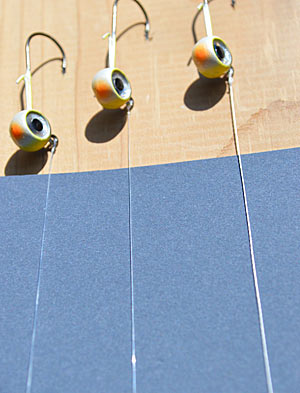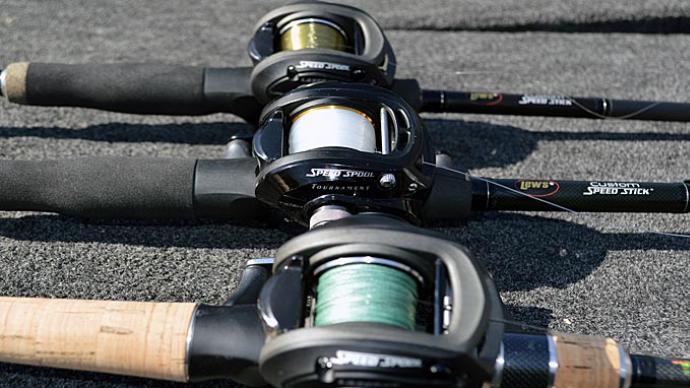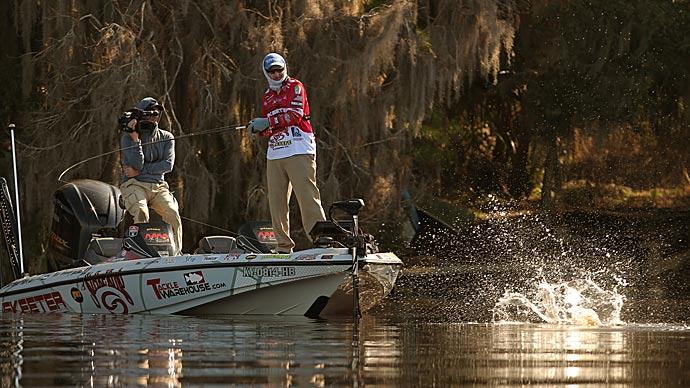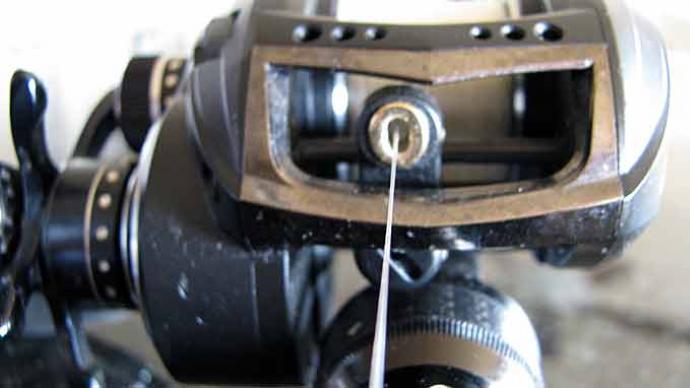
The fishing line is the connection between you and the bass, as the saying goes. It transfers the action to your lure from your hands, crawling a jig along the bottom or twitching a topwater across the surface. In return, it shares information, including bottom composition and bites. And without it, you’ll never land a single one.
Choosing a line used to be simple: Visit your local tackle shop and pick from only a few. But like all of today’s bass-fishing gear, the line has become specialized. Make that same visit now, and you’ll face a wall of line choices, including brand, size, color, and material. It can be an intimidating situation. But it’s one that you should wade into, even if you technically could fish the same line in every situation you float across.
Using the perfect line for where and how you’re fishing at the moment increases performance, creating more lifelike presentations, feeling strikes better, or improving the percentage of bass landed. Making that happen requires understanding the traits that determine how a line performs, then finding the one with the right combination. And it starts with the material from which it’s made.
Understand monofilament
In the 1950s, a process was developed to extrude plastic into single fibers of different diameters. That bore many items, including a monofilament fishing line. While the first ones proved unwieldy and thus unpopular with anglers, DuPont improved the product by the decade’s end, introducing better behaving Stren, which is now made by Pure Fishing. Other brands soon followed, along with variations such as copolymers and coatings.
Monofilament remains popular today. It’s affordable, and bass anglers of all skill levels find it easy to use. It floats, holds fast with various knots, and is available in various colors and sizes.
But the good comes with some bad. Monofilament has to be replaced regularly and has memory — the loops and curls that remain in the line after it unwinds from a spool — which causes casting issues. It has the most stretch of any line type, and while that’s helpful in some situations, it dulls sensitivity.
Understand braid
Before monofilament, most fishing line was braided from natural materials such as cotton and silk. Anglers had to remove it from their reels between trips, using gadgets that allowed it to dry and not rot. But with the development of space-age fibers, such as Dyneema and Spectra, a new generation of braid arrived in the early 1990s.
Braid is the most sensitive fishing line, thanks to fibers that don’t stretch. They have small diameters and are indestructible, cut only by the sharpest scissors. That makes it highly abrasion-resistant. Dock posts, thick aquatic vegetation, brush piles, and zebra mussels aren’t much of threats. It will do your heaviest lifting.
But braid is expensive, and its slick fibers render some knots useless; the Palomar knot is one of the best. It also is opaque, easily seen by anglers and bass in all but the muddiest water, even when colored green, black, or bronze by the manufacturer.
Understand fluorocarbon
If monofilament and braid are the extremes, then fluorocarbon is right in the middle of the fishing-line spectrum. It’s not new; bass anglers have put it to work for at least a couple of decades. What makes it unique is how it packages positive traits of the others beneficially.
At first glance, fluorocarbon looks like monofilament, primarily due to its lack of color. It refracts light nearly as water does, making it invisible when in use. It holds all knots and comes in various sizes, including 4-pound test for smallmouth swimming in clear water and 25-pound test for largemouth buried in thick cover. It feels stiff, contributing to memory and “exploding” off spinning reel spools. And unlike monofilament, it sinks.
Besides being more expensive than monofilament, fluorocarbon is like a braid in other ways. It stretches very little, making it powerful and sensitive. It also is abrasion-resistant.
Match your outfit
Spinning and casting reels handle line differently. While line made from any of the three materials can be used on casting reels, limper monofilament and braid are better suited for twisting and turning spinning reels. That separation applies to line weight, too—fish lighter ones on spinning reels, heavier ones on casting reels.
Match your rod to the line, too. Start by staying within the manufacturer’s recommended pound-test range, especially at the lower end, then find an action that complement’s the line. Texas-rigged worms fished on monofilament, for example, demand a fast-action rod that can overcome stretch and powerfully set a hook through soft plastic into a bass. It’s the opposite with braid, which demands a slow-action rod. Without stretch, you only need to flick your wrist or pull back and spin the reel handle several times to set the hook.
Match your presentation
Your line choice also is determined by the lure you want to fish. Monofilament, for example, remains the choice for topwater fishing. It floats, helping lures stay on the surface, and its stretch adds delay to hook sets, giving bass more time to grab your offering. That stretch also acts like a shock absorber, keeping hooks from ripping out on hard strikes, especially with fast-moving lures, which is more critical than sensitivity here. It also keeps tension on treble hooks, which spread your pressure across six or more points. Any slack line created from an errant rod movement or bass jump can allow them to be thrown.
Sinking fluorocarbon, on the other hand, isn’t for topwaters. But that trait helps crankbaits dive deeper, and lightly weighted jigs and soft-plastic lures stay on the bottom. And its toughness makes it the right choice for bass hiding in heavy cover flooded with clear water.
There isn’t cover heavy enough to stop braid. It’ll bring back pounds of vegetation and brush along with your bass. So, reach for it when you need to go in after them or you’re slinging your heaviest lures such as umbrella rigs.
Braid has a soft side, too. And that, along with it being slick enough to sail off spools and through line guides, makes it the best choice for casting tiny lures long distances. It’ll send the small swimbaits that smallmouth love, for example, out of sight, across shallow-water flats.
Consider pound test

Since the first spool of line was sold, anglers have bought based on a line’s pound test, a rating that reveals the maximum amount of stress it can withstand. Remember that applies to the line alone. Add the cushioning of a rod and well-adjusted drag, and you can catch bass whose pounds and pressure surpass the rating.
Pound-test remains an important consideration, pointing you to a powerful line for the lure and cover you are fishing. If that’s sparse, for example, you can fish with as light of a line as you want. But if you’re pulling a heavy spinnerbait and crankbait, you’ll want something stronger to match the resistance of your lure and fight of a bass.
Consider diameter
The pound test doesn’t work alone. It’s directly tied to diameter. In general terms, a line’s diameter increases with its pound-test rating. Exceptions can be found between manufacturers; one’s 10-pound test monofilament or fluorocarbon, for example, can be thinner than another’s. And while that difference is often microscopic, it can make a big difference along the distance of a cast in certain situations, including helping your lure dive deeper because of reduced resistance.
Braid packs the most power in the smallest space. Most 30-pound test braids, for example, have the same diameter as 8-pound test monofilament. The diameter becomes whisper-thin if you drop to 8- or 6-pound test braid. That gives you more casting distance, diving depth, and lure action.
Pick a color
Braid’s sensitivity is a big plus in clear water, where small lures are often fished at great depths. It makes even the slightest bump feel like a solid tug. But what doesn’t play well there is its visibility. Whether that turns off anglers or bass more is up for debate, but it can be remedied by running a black or green permanent marker in 4-inch streaks along the several feet in front of your lure.
Fluorocarbon is the least visible, so it’s the natural choice in clear water. But don’t count out monofilament if you want to hide your line. It comes in many colors, most of which are translucent hues, from high-visibility yellow to stealthy transparent. Green is one of the most popular because it gets lost in many conditions, from open, clear water to inside beds of aquatic vegetation.
Tie on a leader
With frogging and flipping being notable exceptions, many anglers add a monofilament or fluorocarbon of similar diameter length between their lure and braided line when fishing vertical lures such as worms and jigs. Its purpose is to hide the braid from bass — or give the angler the confidence that that’s happening — while preserving the braid’s sensitivity and strength. It also saves money. You’ll repeatedly use less braid retying to a leader, especially if yours starts 8 to 10 feet long.

Attaching the two is simple. The most popular knots are the Alberto and Double Uni knot. Some anglers prefer the FG, which takes more practice and patience to tie but moves through line guides easier.
Add backing
Don’t toss a spool of almost empty lines, especially if it’s a larger pound test. While some of today’s reels — spinning and baitcasting — have shallow spools that hold fewer yards of line, many have traditional deep spools. And no matter how well you cast, you’ll never reach the inner layers of those. So, that line goes unused.
Instead, first fill these reels with backing, a line whose sole purpose is to take up space. Larger diameter lines do that quicker than smaller ones, but either work. Fill from a quarter to half of the reel’s capacity, attach the line you want to fish with using any of the knots that attach leaders and fill the reel. When it’s time to change the line, strip to the backing and tie on the new line.
Keep the backing until it’s time to clean, lube, or repair the reel. Even then, removing it isn’t required. It works with monofilament and fluorocarbon — match them any way you please. But it’s vital with braid, which will spin when directly tied to a spool; no matter how much you turn the handle, you won’t be able to retrieve it. Winding on some fluorocarbon or monofilament — even a few wraps on a shallow spool — first gives it traction.




